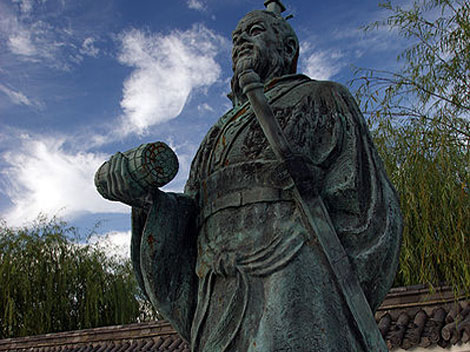Concentrate Your Weapons on Your Opponent's Weakness
 Saturday, October 15, 2011 at 04:14PM
Saturday, October 15, 2011 at 04:14PM  CAtennis
CAtennis Sometimes, when you perceive a chink in your opponent's armor, it is important to focus your weapons on hammering away at that weakness. Both Carl von Clausewitz (Prussian military theorist) and Sun Tzu would agree that a maximum concentration of forces is sometimes the key to winning battles. However, Sun Tzu's advice was slightly different in that he didn't simply believe in overwhelming the opponent by amassing the greatest number of troops. You have to find a way to pound at your opponent's weakness with your strength AND do so at the right time. Otherwise, he is going to find a way to get around the tank artillery no matter how much you shell him.

In terms of tennis, it's not enough to simply lob or rally back a ton of shots to the opponent's backhand (assuming that that's her weakness). Most half-way decent players will actually become better the longer the point goes on assuming that the ball keeps coming the same way in the same spot. The first couple of balls will, of course, give her some difficulty but then the eyes, feet, hands, balance, hips and shoulders will become accustomed to the pace and the same exact shot will not give her problem.
Therefore, it is important - when spotting a weakness in the opponent's game - to pound it into submission but pull away when you feel that your shots are starting to lose effect (i.e., when the opponent gets comfortable with your pace, spin, trajectory and ball positioning). So, for example, let's assume that you're in the middle of an important point with an opponent who has a shaky backhand. You've tried hitting 100 shots toward that backhand and you've won some points and you've lost some points. It's possible that the opponent has managed to plant herself in that corner and starts to hit inside-out forehands. Being 50-50 (i.e. working hard and winning half the points) is simply not good enough. Your energy level will go down and you risk that the opponent may get lucky and/or hit some decent shots and squeeze by you. Therefore, assuming that you have spotted the weakness, find a way to hammer it 2-3 (maybe 4) times in a row; if you don't get the response you want right away (i.e. error or weak response), (a) change direction - get the opponent out of that corner - and (b) then hammer it again (BAM-BAM-BAM!) 2-3 more times. Throw in a couple of slices or some high lobs as well. Don't let the opponent get comfortable with the back against the wall; don't let him dig in and regroup; keep forcing him to make adjustments.
In terms of practice, focus your practice on quick-succession patterns, where you're hitting 5-6 shots with high energy and intensity at 2 targets. Your foot-speed, power, intensity, depth, spin, placement and timing should intensify from shot to shot to the point where your last shot is the best that you can possibly hit. For example, go for the cross-court forehand, then punish a cross-court backhand, followed up by 3-4 quick-succession inside-outs artillery strikes into the opponent's backhand corner. Also, practice soft/medium/hard sequences when hitting cross-courts (i.e., coach hits a consistent pace and player alternates between (i) a high, heavy topspin, (ii) a medium rally pace, and (iii) a blast).
In a match, you will remember to go for the jugular when your first strike draws blood.


